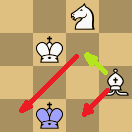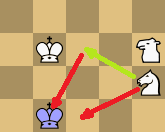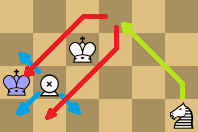Checkmating Applet (3 vs 1)
This page allows you to practice your technique for checkmating a bare King. Just move a piece of the side you want to play with, and the computer will reply with the best move for the other player.
This applet is exclusively for 3-vs-1 end-games, and has some limitations: it assumes none of the pieces would be able to inflict checkmate with only the help of its King, not even help mates. So it will only consider ways of winning that preserve all its pieces, even when sacrificing a piece could lead to a faster mate. For practicing 2-vs-1 end-games, go here.
|
graphicsDir=/membergraphics/MSelven-chess/
whitePrefix=w
blackPrefix=b
graphicsType=png
squareSize=35
useMarkers=1
enableAI=0
symmetry=none
promoZone=0
Fairy piece:X:N:marshall:a1
Fairy piece:Y:N:archbishop:b3
King::K:king:b2,,d4
|
Generating end-game table; Please wait. |
||||||||||||||||||||||||||||
|
|||||||||||||||||||||||||||||
Building EGT... This can take a minute.Design your own pieceIn the pane below you can define moves of a piece by clicking the squares it should be allowed to move to. First click defines a leaper move to the square. A second click would convert this to a slider/rider move that repeats that step/leap. A third click would remove the move again. To limit the range of a slider you can click the first square along its path that it should not be able to reach. Clicking on the piece takes away all its moves, and thus clears the entire pane. After you are satisfied with the move, you can assign it to one of the pieces through the buttons on the right. Note that you can specify divergent pieces by changing the move before you press the button a second time; normally you would just press it twice, though.
|
|||||||||||||||||||||||||||||
Checkmating with pairs
To be able to checkmate with orthodox Kings and a single piece on a rectangular board, that piece would have to cover two orthogonally adjacent squares. When none of your pieces does that (as this applet assumes), your best hope is to force checkmate with two pieces. We will see that some minor pieces are better at this than others. We can distinguish several mating patterns:

Corner mate:
1.Na3+ Ka1 2.Bc3#
Pieces that can do this (such as the Bishop, or Modern Elephant (FA)), are very useful for checkmating, and can do it together with almost any partner, if they are not both excessively weak. Often having 8 moves between the two of them is already enough.

Corner mate:
1.Na3+ Ka1 2.Bc3#
Edge mates - We will call a piece 'forking' if it can attack two squares separated by two orthogonal steps simultaneously. A Knight is an example of this. (But, as we shall see, an unlucky example.) Together with a piece that can attack the square in between, it would be able to deliver checkmate along a board edge. E.g. the forking piece can attack a1 and c1, while its King at b3 keeps the bare King trapped against the edge. It must launch the attack when the bare King is on a1. When the forking piece is not also a piece that can deliver a corner mate (c1-a1 switch), the other piece must have been forcing the bare King into the corner by zugzwang, covering c1, That other piece must then switch its attack from c1 to b1 to deliver the edge mate.
Again this requires a 3-move (uncapture + move + capture) tour, but now to travel from c1 to b1, instead of a1. The ability to do that is thus also useful, although it doesn't help with just any partner; only together with a forking piece. We could say forking and the c1-b1 switch are each half the key to the problem, while a c1-a1 switch is a full solution on its own. The Knight can actually do both: fork a1 and c1, and move from c1 to b1 in 3 moves. So why do two Knights fail to force checkmate? Turns out that to fork a1 and c1, the Knight must be on b3, where its King also has to be to cover a2, b2 and c2. Having the King on a1 is no good for an edge mate, unless the piece that delivers the check on b1 also happens to attack c2 on the side. Again, in theory the Knight could do that, from a1. But again that is exactly where the King has to be! A Wazir on c1 does attack both b1 and c2, though, and can also make the 3-move tour from c1 to b1. So Knight plus Wazir can deliver checkmate.

Double edge mate:
1.Zd4#
Double edged - A rarer pattern occurs with a Ferz, a forking piece that can fork both edges at once: with this you can trap a King on two diagonally adjacent squares near the corner, say b1 and a2. Just put the Ferz on b2, protected by a King on c3. If you now have a piece that attacks diagonally adjacent squares, such as a Zebra, you can deliver mate with it by attacking b1 and a2 simultaneously. And again, a Knight does make such an attack, but only from c3, where the King must be to protect the Ferz without attacking a2 or b1. (Fortunately for Knight and Ferz they can do an edge mate, where the Ferz is the forking piece on b2, and the Knight switches attack from c1 to b1 (e.g. moving from e2 to c3) to deliver mate. But it works only in the corner of the shade of the Ferz, and together N+F are too weak to drive the bare King from the safe corner to the deadly one, so it still is a general draw.)
 This 'user submitted' page is a collaboration between the posting user and the Chess Variant Pages. Registered contributors to the Chess Variant Pages have the ability to post their own works, subject to review and editing by the Chess Variant Pages Editorial Staff.
This 'user submitted' page is a collaboration between the posting user and the Chess Variant Pages. Registered contributors to the Chess Variant Pages have the ability to post their own works, subject to review and editing by the Chess Variant Pages Editorial Staff.
By H. G. Muller.
Last revised by H. G. Muller.
Web page created: 2020-06-23. Web page last updated: 2020-06-23